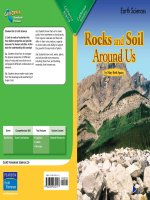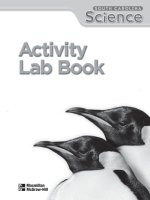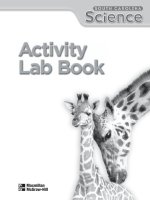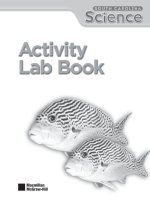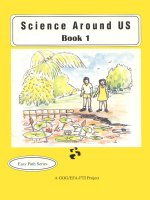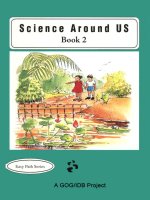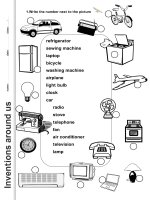science around us book 2
Bạn đang xem bản rút gọn của tài liệu. Xem và tải ngay bản đầy đủ của tài liệu tại đây (2.31 MB, 54 trang )
Science
Around
US
Book2
i
Acknowledgements
The Ministry of Education wishes to acknowledge the work done by the following persons who
were involved in the production of the first edition:
Rookmin Bisnauth
Jennifer Cumberbatch
Elizabeth Mangar
Dwarka Shivraj
Pamala Wong
Bibi Young
Nadia Lockhart
The work of the following persons who were involved in the production of the second edition is
also acknowledged
Sybil Blackman
Melcita Bovell
Sharon Patterson-Bourne
Cecelia Holder
All rights reserved. No part of this publication may be reproduced, stored in a retrieval system or
transmitted in any form or by any means without the prior permission of the copyright owner.
Published by the Ministry of Education Georgetown, Guyana
Printed by VonHoffmann Corporation
Revised 2004 and 2013
Maylene Duncan
iii
FOREWORD
One welcomes the publication of this series of textbooks as part of the Primary Education
Improvement Project funded by the Inter-American Development Bank and the Government of
Guyana.
This series of texts has been long in planning, writing and producing. In the process however,
many Guyanese have developed skills in textbook writing and publication. This will serve
Education well in the future.
We congratulate all those responsible for the production of these texts. They have done a good
job. Guyanese children at the Primary level, and, indeed, the society as a whole, will be the
beneficiaries of their labour.
Thanks to the Inter-American Development Bank for its financial support. Primary Education in
Guyana will benefit considerably with the availability of relevant reading material.
Dale A. Bisnauth
Senior Minister of Education and Cultural Development
Hon. Priya Manickchand
Minister of Education
ii
TABLE OF CONTENTS
Chapter 1 A healthy body 1
Growth and change 3
Inside our body 4
Measuring body parts 6
Chapter 1 Review 8
Chapter 2 Animal Kingdom 9
Movement in animals 9
Birth, growth and change in animals 12
Chapter 2 Review 14
Chapter 3 Plant Kingdom 15
Growth and change in plants 15
Grouping plants 16
Flowering and non-flowering plants 16
Plants with different leaves 18
Chapter 3 Review 20
Chapter 4 Environment 21
Types of Enivronments 21
Care for the environment 22
iii
The importance and uses of soil 23
Chapter 4 Review 24
Chapter 5 Weather 25
Contaminated Drinking Water 28
Chapter 5 Review 29
Chapter 6 Materials 30
Properties of solid materials 30
Mixing colours 31
Chapter 6 Review 33
Chapter 7 Earth and Space 34
Day and night 34
Chapter 7 Review 35
Chapter 8 Energy 36
Sounds and their sources 36
Response to sounds 38
Electricity as a form of energy 39
Ways in which electricity is used 39
How can we generate electricity? 40
How can we use electricity wisely? 40
iv
Using electricity safely 41
Chapter 8 Review 42
Chapter 9 Forces 43
Direction of forces 43
The effects of forces 43
Some simple machines 43
Chapter 9 Review 45
1
CHAPTER 1 A HEALTHY BODY
We need to keep our bodies healthy!
Being unhealthy prevents us from doing many of the things we love.
How can you keep your body healthy?
We can keep our bodies healthy by:
1. Eating balanced diets – A balanced diet contains all the right
foods we need in the right quantities.
Activity
Get pictures of different foods. With the help of your teacher,
identify which ones are healthy for you and which ones are not
healthy for you.
2. Exercising- Exercising helps to keep our bodies fit.
Can you list some different ways of exercising?
3. Keeping our bodies and environment clean – It prevents us
from getting ill.
2
Activities that keep us healthy
Identify other ways of keeping your body healthy.
Brushing teeth
Sleeping
Bathing
Washing hands
3
GROWTH AND CHANGE
All of us grow. Humans (we) grow from babies to children then to adults.
What are the differences among the persons in the pictures? Do they
have different body shapes and sizes? What do you notice about their
hair?
They also eat different types of food. We can say that they have different
diets. What type of foods do you eat? Would a baby eat the same foods
as you?
They can also do different physical things. The baby cannot walk but the
child and adult can walk.
Baby
Child
Adult
4
INSIDE OUR BODY
Have you ever seen inside your body? Do you know what is present
inside your body? There are many things present inside our bodies.
Some main or major parts inside our bodies are:
The heart
The stomach
The lungs
5
The liver
The kidneys
The brain
6
MEASURING BODY PARTS
How tall are you?
We can measure some of
our body parts by using a
ruler or a tape. Some body
parts are:
Head
Waist
Hand
Foot
Arm
Activity
Have your friends use a ruler or tape to measure your height, waist, hand
span.
You can measure your friend as well. Record the information in a table
like the one below.
Name
Height (cm)
Pat
Paul
7
What can you say about the heights of your friends and yourself?
Look at the graph on the next page and answer the questions below.
Who is the tallest?
Who is the shortest?
Which persons have the same heights?
8
CHAPTER 1 REVIEW
Circle all the healthy habits from the list below.
1. Combing your hair
2. Not sleeping
3. Brushing your teeth
4. Eating a balanced diet
5. Bathing once per week
6. Washing fruits before you eat them
7. Throwing your litter on the floor
What is the missing stage in the growth of humans below?
Baby _______________________ Adult
Name three main parts inside your body
1. ___________________________
2. ___________________________
3. ___________________________
9
CHAPTER 2 ANIMAL KINGDOM
MOVEMENT IN ANIMALS
How do you move from one place to another?
Animals move in different ways.
Some animals fly
Some animals swim
10
Some animals crawl
Some animals walk, run and jump
11
Some Animals Move In Different Ways
Name the different ways in which you can move.
Look at the pictures above. Name the different ways in which the parrot
moves.
Look at animals in your community and identify the way or ways in which
they move.
12
BIRTH, GROWTH AND CHANGE IN ANIMALS
Some animals, like lizards and chickens are hatched.
They develop in eggs, outside their mother, and then hatch.
Humans and animals like the sheep are born.
They develop inside their mothers and are then born
13
After birth, animals go through many physical changes in their size,
shape, colour, covering, teeth etc. The human being is a good example.
Are babies born with teeth? Do adults have teeth? Is an adult larger than
a baby?
Activity
Look at the pictures which follow and list the differences you notice
between the young animal and its mother.
14
CHAPTER 2 REVIEW
1. Name an animal that
i. Runs ____________________
ii. Jumps ____________________
iii. Swims ____________________
iv. Flies ____________________
v. Crawls ____________________
2. One animal that is born is the ______________.
3. One animal that lays eggs is the _____________.
4. After birth animals go through changes like ______________,
_____________ and ___________.
15
CHAPTER 3 PLANT KINGDOM
GROWTH AND CHANGE IN PLANTS
Changes that occur in the life-cycle of a plant
Typical Plant Life Cycle
The seed in the cycle sprouts and produces a seedling which is an
immature plant. As a seedling grows into an adult plant several changes
occur. It gets bigger in size and produces more leaves. Some plants
produce flowers which produce seeds. This is the general life cycle for a
flowering plant. Not all plants produce flowers and not all plants come
from seeds!
Seedling
Mature
plant
Flower
(on mature plant)
Seed
16
GROUPING PLANTS
We can group plants differently.
We can separate plants with flowers from plants without flowers. Plants
also have different types of leaves.
FLOWERING AND NON-FLOWERING PLANTS
Plants that bear flowers are flowering plants e.g. sunflower, daisy and
apple tree. Some plants which bear flowers have fruits.
17
Plants which do not bear flowers are non-flowering plants e.g. ferns,
Christmas tree.
18
PLANTS WITH DIFFERENT LEAVES
We can group plants according to their leaves. There are many kinds of
leaves. They may differ in size, shape and colour. Leaves differ in other
ways too. Look carefully at the leaves below.
Can you see the lines on the leaves?
These lines are called veins.
Look at the patterns made by these veins.
Are they all the same?



